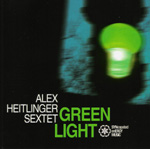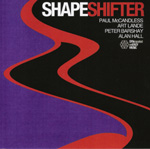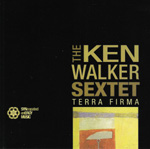| |
Synergy Music :
Label Profile
by Jay Collins
February 2005
When considering the hotbeds of mainstream jazz, the Denver-Boulder, Colorado
area is hardly one that immediately springs to mind. Thus, it may come
as a surprise to learn that not only are there several well-known musicians that
reside in the area, like Hugh Ragin, Ron Miles, Fred Hess, Dianne Reeves, and
local legend, Art Lande, but that there is also a vibrant and exciting regional
scene at work.
One of the brightest spots is the existence of an independent label, Synergy
Music. Formed in 1996 by Michael Fitts, a jazz lover and former sound engineer,
this “labor of love” was designed with an aim to help talented musicians
release their music. Since its formation, the label has released approximately
20 titles, seeking to “showcase original, creative, primarily acoustic
jazz music”, drawing artists from mostly the Denver-Boulder region. Looking
at said catalog, the music has a bit of a bipolar focus, that of both mainstream
jazz of the hard bop variety, as well as “ECM with an attitude”.
The most visible of Synergy Music’s artists is pianist/composer/drummer
Art Lande, arguably the label’s muse. For those unaware of Lande,
in the words of the label’s GM, Mitchell Feldman, “Art has been a
mentor to generations of jazz artists in the Denver-Boulder area for the past
25 years.” Furthermore, he is “probably the most world-class
master musician in the Denver-Boulder area”. An incredibly prolific
performer with a seemingly endless stream of music, Lande spent the 70s gigging
with bright lights like Steve Swallow, Ted Curson, and Jan Gabarek and his quartet
Rubisa Patrol, which released its debut on ECM. After work in Europe, Lande
relocated to Boulder and has been there ever since. Though also a drummer,
Lande’s piano skills demonstrate an incredible depth that allows for his
staunch romanticism (a la Bill Evans) and fluid touch to meld well with his hearty
improvisational aspirations.
In addition to Lande’s many appearances (causing some to wonder if Synergy
Music was run by Lande himself), there are several nuggets in the back catalog;
though frankly, about half of its past releases are either somewhat mundane or
flat-out weak. The strongest releases include sessions from local tenor
legend, Billy Tolles, who recently passed away, driving bop from Convergence,
a cooperative featuring saxophonist John Gunther and trumpeter Greg Gisbert,
a live date from the Paul Warburton Quartet with Ron Miles, another co-led session
from trumpeter John McNeil and reedist Kenny Berger, the inspired organ trio,
Tri-Ocity and two vocal sets from Mary Ann Moore. An important aspect of
the label’s future turns on the fact that Synergy Music is part of a privately
held pool of companies under the Synergy Media Group. Accordingly, Synergy
Music has the luxury of having a jazz retail and press promotion under the same
roof (INDIEgo Jazz Promotions) as well as an independent distributor (Synergy
Distribution, who also distributes Accurate, Enja Records, and Smalls, among
others). As Feldman notes, “if it weren’t for these sister
companies, it would not be possible to have the label.”
Synergy Music could have continued its practice of documenting local artists
that fit within its stylistic vision, without much marketing push and a lack
of a firm visual concept. However, the label decided to broaden its horizons
by bringing in industry veteran/marketing guru/journalist/auteur Feldman in January
of 2004. Feldman’s presence was felt almost immediately, due not
only to his decision-making with respect to the label’s future output,
but also with regard to the look of the label’s releases. Feldman
says, “One of the first things that I did was to work with the label’s
art department to come up with a new look. I gave them a book of Reid Miles
covers [Blue Note: The Album Cover Art] to see what they could come up
with.” Feldman also refined the existing logo and developed a catch
phrase: “I like to play with words and as a result, I came up with the
SYNcopated enERGY MUSIC tagline.” These two developments created
a new stylistic concept for the label, something that it lacked previously. The
result is a consistent and instantly recognizable look that makes its first appearance
on the four releases considered here, as well as a promotional sampler that Feldman
compiled, SYNcopated enERGY, which serves as an introduction to the label’s
highlights.
 Of the four
new releases, first up is Green Light, trombonist Alex Heitlinger’s
debut that collects a sextet of Denver-based musicians, including saxophonist
Peter Sommer, Lande, bassist Dwight Kilian, drummer Jill Frederickson, and of
particular note, trumpeter Greg Gisbert. As for Heitlinger, only 24 and
a recent New York transplant, he demonstrates great promise through his knack
for writing catchy melodies. Throughout the ten-song program, all composed
by Heitlinger, the sextet navigates mostly bop terrain with corresponding levity
that reflects the overall optimism inherent in Heitlinger’s writing and
of the proceedings as a whole. The real key, though, is the colorful horn
arrangements that are broadcasted immediately on the opening “Green Light”,
a buoyant, yet driving piece that demonstrates the group’s highly interactive
level and the strident work of Lande’s piano. Of the four
new releases, first up is Green Light, trombonist Alex Heitlinger’s
debut that collects a sextet of Denver-based musicians, including saxophonist
Peter Sommer, Lande, bassist Dwight Kilian, drummer Jill Frederickson, and of
particular note, trumpeter Greg Gisbert. As for Heitlinger, only 24 and
a recent New York transplant, he demonstrates great promise through his knack
for writing catchy melodies. Throughout the ten-song program, all composed
by Heitlinger, the sextet navigates mostly bop terrain with corresponding levity
that reflects the overall optimism inherent in Heitlinger’s writing and
of the proceedings as a whole. The real key, though, is the colorful horn
arrangements that are broadcasted immediately on the opening “Green Light”,
a buoyant, yet driving piece that demonstrates the group’s highly interactive
level and the strident work of Lande’s piano.
Other high spots include the jagged waltz of “Crazy Jake”, which
ratchets up the excitement level once Heitlinger takes center stage, a performance
that reminds one of the joy of a carnival. The polyphony from the horns
also inspires, as does Sommer’s sonorous soprano work. The front
line also becomes rather feisty during the persnickety “The Foot”,
perhaps the session’s most “outside” venture. Heitlinger’s
sensitivity also shines through on the pensive “Dusk”, which eventually
locks into a modal groove, as well as the picturesque waltz “Missing You”,
which features marvelous work from Gisbert, demonstrating why he is such a hot
commodity in New York. Considering the whole, then, this record is sure
to please those looking for a mix of mainstream jazz and announces the arrival
of a name to watch.
 When one considers
reedist Paul McCandless, the first thing that’s likely to come to mind
is his West-meets-East “world fusion” group, Oregon. Known
for his oboe work in Oregon, McCandless interestingly focuses on other reeds
here. While there are several lighter-edged compositions, the variety of
this release is unexpected, especially due to the appearance of freely improvised
pieces. The eleven-song program of melodic contemporary jazz—scripted
entirely by Lande—focuses on the interface between McCandless and the pianist,
ably assisted by bassist Peter Barshay and drummer Alan Hall. When one considers
reedist Paul McCandless, the first thing that’s likely to come to mind
is his West-meets-East “world fusion” group, Oregon. Known
for his oboe work in Oregon, McCandless interestingly focuses on other reeds
here. While there are several lighter-edged compositions, the variety of
this release is unexpected, especially due to the appearance of freely improvised
pieces. The eleven-song program of melodic contemporary jazz—scripted
entirely by Lande—focuses on the interface between McCandless and the pianist,
ably assisted by bassist Peter Barshay and drummer Alan Hall.
The majority of the pieces feature McCandless’ soprano work, with the lion’s
share utilized on the introspective pieces. Tracks like “Majestorum
Enborum”, “Pompanuk Pond”, and the record’s closer, “Musiverse”,
feature a tranquil, poetic approach that relies on soaring harmonies and drummer
Alan Hall’s gliding cymbal work. The tender ballad “Angels
In The Sky” and the laid back, cinematic “Sultana” also help
to create the record’s reflective mood. It’s not all easy street,
though, as the hard-swinging “Pietroglyph” has this group at its
most energized, sparked by McCandless and Lande’s interplay. McCandless
also takes a turn on bass clarinet on “Shapeshifter”, with Lande’s
vibrant chords walking in the blues arena.
Perhaps the biggest surprise is that after a career spanning three decades, this
is McCandless’ first formal tenor appearance. The 6/8 march of “Rigamarole”,
then, is a fitting intro, with McCandless’ bold tone working with Barshay’s
sturdy maneuvers and Lande’s rollicking double-time swing. The previous
being said, perhaps the second biggest surprise is the appearance of three freely
improvised tracks, including the rustling “Rattling The Cage”, the
energized swing of “Argument”, and the dreamy “On A Misted
Moor”, highlighted by McCandless’ English horn. Overall, a
surprisingly diverse set from this quartet that provides further evidence of
the vitality of the McCandless-Lande partnership.
 Bassist Ken
Walker is a busy man around town, though looking at the personnel, one has to
wonder—“who the heck are these guys?” Terra Firma finds
Walker in the company of a sextet that includes trumpeter Al Hood, tenor saxophonist
Peter Sommer, guitarist Dave Corbus, pianist Jeff Jenkins, and drummer Paul Romaine. As
liner note scribe/legend Benny Golson notes after reviewing each musician’s
CV, however, “these guys are not any ‘poop butt’ musicians”. Keeping
that maxim in mind, this eleven-song program of straight ahead jazz mixes band
originals and several appealing covers. Right off the bat, the secret weapon
here is pianist Jenkins, who contributes rich, McCoy Tyneresque chord structures
and electrifying runs to spark pretty much every track. Bassist Ken
Walker is a busy man around town, though looking at the personnel, one has to
wonder—“who the heck are these guys?” Terra Firma finds
Walker in the company of a sextet that includes trumpeter Al Hood, tenor saxophonist
Peter Sommer, guitarist Dave Corbus, pianist Jeff Jenkins, and drummer Paul Romaine. As
liner note scribe/legend Benny Golson notes after reviewing each musician’s
CV, however, “these guys are not any ‘poop butt’ musicians”. Keeping
that maxim in mind, this eleven-song program of straight ahead jazz mixes band
originals and several appealing covers. Right off the bat, the secret weapon
here is pianist Jenkins, who contributes rich, McCoy Tyneresque chord structures
and electrifying runs to spark pretty much every track.
The many highlights of this disc commence with George Coleman’s “Amsterdam
After Dark”, a Latinesque bop that sets the pace immediately, with Jenkins’ work
being particularly exciting before he yields to Hood’s bright lines and
a tasty excursion from Romaine. Next up is Eddie Harris’ bop anthem “Velocity”,
which cooks along nicely, as well as the aptly titled “Boogie Woogie Bossa
Nova”, which makes for an interesting rhythmic scheme and a great feature
for Corbus’ lyrical attack. Likewise, the offbeat arrangement of
Cole Porter’s “Just One Of Those Things” leaves the group with
plenty of wiggle room.
Walker’s own compositions prove memorable and look to the Golden Age of
bop, with dashes of Blue Note here and there, as well as nods to the great records
of the era. High points include the funky swing of “Ms. P & P”,
with the help of Sommer’s forthright tenor statements, and the hard swing
of “Terra Firma”, where Sommer demonstrates that he is more than
happy to ruffle a few feathers. The group also demonstrates its serenity
during the Latin breeze of “Mi Nena” with a sensitive Sommer and
Hood’s sweet flugelhorn, as well as on the gorgeous ballad “Blackberry
Winter”. Walker also allows a brief moment in the spotlight for himself
on the Oscar Pettiford sounding (as in “Tricotism”) “Blues
For P.K.”, a tasty blues. Finally, Jenkins also shines again on his
own “Highlife”, a memorable composition that reminds of Horace Silver’s
sanguinity with everyone feeling good (and shaking their rumps). This is
a top-notch bop record that’s pretty much as good as it gets.
 Perhaps the
main reason that folks are going to be checking out Synergy Music has to do with
the appearance of two masters on the label, namely saxophonist Archie Shepp and
pianist Mal Waldron. This 2002 Parisian date, licensed from Enja Records,
pairs the duo for a moving tribute to Billie Holiday. This ten-song program
creates a late-night vibe that is an apt testament to Holiday’s legacy,
as well as to Waldron, who appears in one of his last, if not the last
recording before his passing. Waldron, Holiday’s accompanist during
her last days (who, incidentally, has two other Left Alone discs, one
with a trio, and the other, Left Alone ’86, a duet with Jackie McLean),
performs with a revelatory level of restraint and an arresting sincerity. His
rich chordal structures coax Shepp repeatedly and also sparkle during his vibrant
solo turns. As for Shepp, his raspy, Ben Websterish tone remains vital,
as he conveys a beguiling amount of emotion with each breath, despite his arguably
limited technical skillset. In fact, it is this fragile, awkward
beauty (yes, this is the same “angry young tenor”) that keeps one
returning for additional courses. Perhaps the
main reason that folks are going to be checking out Synergy Music has to do with
the appearance of two masters on the label, namely saxophonist Archie Shepp and
pianist Mal Waldron. This 2002 Parisian date, licensed from Enja Records,
pairs the duo for a moving tribute to Billie Holiday. This ten-song program
creates a late-night vibe that is an apt testament to Holiday’s legacy,
as well as to Waldron, who appears in one of his last, if not the last
recording before his passing. Waldron, Holiday’s accompanist during
her last days (who, incidentally, has two other Left Alone discs, one
with a trio, and the other, Left Alone ’86, a duet with Jackie McLean),
performs with a revelatory level of restraint and an arresting sincerity. His
rich chordal structures coax Shepp repeatedly and also sparkle during his vibrant
solo turns. As for Shepp, his raspy, Ben Websterish tone remains vital,
as he conveys a beguiling amount of emotion with each breath, despite his arguably
limited technical skillset. In fact, it is this fragile, awkward
beauty (yes, this is the same “angry young tenor”) that keeps one
returning for additional courses.
One of Holiday’s signature pieces, “Easy Living”, starts the
proceedings off with a soulful and romantic reading from Shepp and Waldron’s
smoldering tones. Similarly, “Porgy” and “Lady Sings
The Blues” reflect the deep romanticism of the duo. Waldron’s “Left
Alone” is also deeply felt, with the pianist’s shimmering chords
highlighting his tenacious restraint. On the other hand, “Nice Work
If You Can Get It” has the pair in a joyous place, as does the cautiously
optimistic “When Your Lover Has Gone”. Of course, who could
miss the Shepp blues vocalizing on “Blues For 52nd Street”, with
Waldron laying down thick chords beneath the testimonials.
Shepp also brought along his soprano sax for the date and, in contrast to his
tenor work that contains shades of his gruff past, his playing on the straight
horn reflects a fitting vulnerability. For instance, his forlorn approach
fits the tenderness of “Everything Happens To Me” beautifully,
as does the reserved, yet happy-go-lucky feel of “I Only Have Eyes For
You”. As a whole, Left Alone Revisited is a beautiful duet
that demonstrates a spiritual connection between these legends and the material.
In conclusion, these four releases demonstrate an exciting new step for Synergy
Music. When discussing what the future holds for the label, Feldman noted
that Synergy is “hungry and looking for new artists”. Seeking
to broaden their horizons and with an eye towards national recognition, Feldman
states that the label will continue with its stated goals, seeking to promote
emerging talent. Here’s to a bright future and recognition beyond
Colorado’s borders.
|
|
|
|
|

